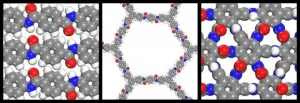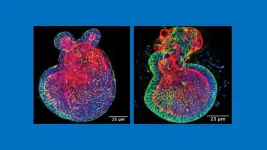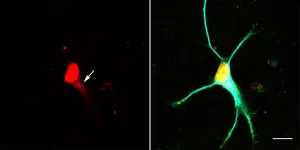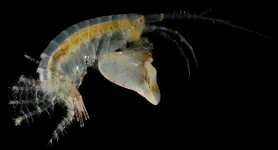(Press-News.org) ADELPHI, Md. -- Army researchers reached a breakthrough in the nascent science of two-dimensional polymers thanks to a collaborative program that enlists the help of lead scientists and engineers across academia known as joint faculty appointments.
Researchers from the U.S. Army Combat Capabilities Development Command, now known as DEVCOM, Army Research Laboratory partnered with Prof. Steve Lustig, a joint faculty appointment at Northeastern University, to accelerate the development of 2D polymers for military applications.
The collaboration with ARL Northeast led to a groundbreaking study published in the peer-reviewed scientific journal Macromolecules. Editors featured the research in a cover article.
"2D polymers have been studied very seriously from a synthetic viewpoint for only about 10 years," said Dr. Eric Wetzel, research area leader for Soldier Materials at the laboratory. "They represent a new, relatively unexplored class of materials with tremendous potential."
According to Wetzel, 2D polymers have a very repeatable, symmetric pattern akin to "chicken wire," which offers access to more structural enhancements compared to one-dimensional, linear polymers like Kevlar.
In an effort to gauge the full potential of these materials, Army researchers have started to computationally design 2D polymers in the hopes that they may develop a superior alternative to conventional aramid fibers for applications such as armor and fire-resistant clothing.
Prof. Steve Lustig, a joint faculty appointment at Northeastern University, uses his industry experience with DuPont to help Army researchers calculate the environmental durability of simulated 2D polymers.
In order to properly create a 2D polymer that can withstand real-world conditions, Army researchers sought the aid of Lustig, who previously worked at DuPont Central Research & Development for over two decades before he became an associate professor with tenure at Northeastern University.
"The idea of the 2D polymer project is essentially to make a 2D version of Kevlar," Lustig said. "I had over a decade of experience working with the Kevlar business in various aspects of liquid crystalline polymer polymerization, processing and properties. The ARL team believed that my background would be helpful."
Lustig explained that he had first learned about the laboratory in the mid-2000s when he came in contact with Dr. Kenneth Strawhecker, an Army scientist who had reached out to DuPont in search for industry collaborations.
At the time, Lustig worked as a lead scientist in DuPont's polymer physics group and specialized in the development of novel tools for statistical mechanics, statistical thermodynamics and molecular simulations.
In addition to his expertise on the computational side of industrial research, he also conducted experiments in chemical synthesis, polymer processing, polymer material property characterization and atomic force microscopy.
"I have never had the patience to stay in one place and become a master in just one very small area," Lustig said. "I've always tried to solve problems holistically using experiments, theory and computers."
Once Lustig met with Strawhecker, the two began a series of informal collaborations that focused on the use of atomic force microscopy to understand not only the structure of Kevlar materials but also their response to tensile strain and bending mechanics.
The scientific journal Macromolecules features the Army-led study on the inside cover of its latest issue.
The American Chemical Society later published the outcome of this research as the cover of the peer-reviewed scientific journal Applied Materials & Interfaces in 2020.
Even after Lustig left DuPont in 2016, he continued his collaborations with the laboratory as a visiting scientist. Shortly after one of his seminar presentations at the lab, he met Wetzel, who immediately recognized the value of Lustig's industry experience.
Over the course of his continued interaction with Strawhecker and Wetzel, Lustig obtained the opportunity to become an ARL Joint Faculty Appointment after he joined the Department of Chemical Engineering at Northeastern University.
Due to his close proximity to ARL's Northeast campus, both Strawhecker and Wetzel saw Lustig as a top candidate for the position.
"The ARL Open Campus Initiative provides a way to tap into outside expertise that may not exist within our laboratory," Wetzel said. "The joint faculty appointment is a new construct within Open Campus that has only existed for a few years, but we were able to integrate an expert with years of experience at DuPont into our research program thanks to this mechanism."
According to Wetzel, Lustig's long history with high performance fiber development projects at DuPont provided Army researchers with access to unique modeling capabilities as well as invaluable guidance on the methods and techniques that would enhance the stability of their conceptual 2D polymers.
As a joint faculty appointment, Lustig analyzed the environmental durability of the lab's 2D polymer designs and ran computer simulations that determined how well they endure extreme conditions such as intense heat.
Lustig worked alongside Dr. Jan Andzelm, an Army scientist and ARL fellow whose expertise in the molecular simulations of polymers were critical for running the calculations.
Through these computer simulations, the researchers compared the thermal stability of the 1D polymer Kevlar, a 2D polymer called an amide covalent organic framework, known as amCOF, and a hypothetical 2D polymer designed by the laboratory called graphamid.
"We performed a series of very accurate, high-level quantum mechanical calculations called ab initio molecular dynamics and studied the changes in the structure between the three molecules we looked at," Lustig said. "Once we confirmed that our method could accurately describe a well-known molecule like Kevlar, we could apply it to molecules we didn't know like graphamid and make accurate predictions about their behavior and properties."
The results of the comparison study showed that graphamid could potentially withstand temperatures as high as 700 degrees Celsius, which exceeded the limits of both Kevlar and the amCOF material.
Given the study's acceptance as a cover article, Lustig said he believes that the team's latest success clearly highlights the importance of ARL Open Campus initiatives such as the joint faculty appointments.
Lustig expressed his gratitude to the laboratory for his position and mentioned how he viewed the opportunity as an excellent way for him to help the Army with its efforts.
"I got involved with Kevlar in the first place because my father was career Army, so the idea of protecting guys like my dad is really important to me." Lustig said. "I feel very excited that we'll be able to offer Soldiers new materials to make their work easier and safer."
INFORMATION:
Researchers have developed a tool to identify security and privacy risks associated with Covid-19 contact tracing apps.
COVIDGuardian, the first automated security and privacy assessment tool, tests contact tracing apps for potential threats such as malware, embedded trackers and private information leakage.
Using the COVIDGuardian tool, cybersecurity experts assessed 40 Covid-19 contact tracing apps that have been employed worldwide for potential privacy and security threats. Their findings include that:
72.5 per cent of the apps use at least one insecure cryptographic ...
Medical researchers have long understood that a pregnant mother's diet has a profound impact on her developing fetus's immune system and that babies -- especially those born prematurely -- who are fed breast milk have a more robust ability to fight disease, suggesting that even after childbirth, a mother's diet matters. However, the biological mechanisms underlying these connections have remained unclear.
Now, in a study published Feb. 15, 2021, in the journal Nature Communications, a Johns Hopkins Medicine research team reports that pregnant mice fed a diet rich in a molecule found abundantly in cruciferous vegetables -- such as broccoli, Brussels sprouts and cauliflower -- gave birth to pups with stronger protection against necrotizing enterocolitis (NEC). ...
Neurodegenerative diseases, such as various forms of senile dementia or amyotrophic lateral sclerosis (ALS), have one thing in common: large amounts of certain RNA-protein complexes (snRNPs) are produced and deposited in the nerve cells of those affected - and this hinders the function of the cells. The overproduction is possibly caused by a malfunction in the assembly of the protein complexes.
How the production of these protein complexes is regulated was unknown until now. Researchers from Martinsried and Würzburg in Bavaria, Germany, have solved the puzzle and now report on it in the open access journal Nature Communications. They describe in detail a signaling pathway that prevents the overproduction of snRNPs when they are not needed. The results should ...
A diet rich in human food may be wreaking havoc on the health of urban coyotes, according to a new study by University of Alberta biologists.
The research team from the Faculty of Science examined the stomach contents, gut microbiome and overall health of nearly 100 coyotes in Edmonton's capital region. Their results also show coyotes that consume more human food have more human-like gut bacteria--with potential impact on their nutrition, immune function and, based on similar findings in dogs, even behaviour.
"If eating human food disturbs the 'natural' coyote gut bacteria, it is possible that eating human food has the potential to affect all ...
The answer to the age-old mystery of the evolutionary origins of vertebrate eyes may lie in hagfish, according to a new study by biologists at the University of Alberta.
"Hagfish eyes can help us understand the origins of human vision by expanding our understanding of the early steps in vertebrate eye evolution," explained lead author Emily Dong, who conducted the research during her graduate studies with Ted Allison, a professor in the Faculty of Science and member of the U of A's Neuroscience and Mental Health Institute. "Our findings solidify the hagfish's place among vertebrates and open the door to further research to uncover the finer details ...
Blocking seizures after a head injury could slow or prevent the onset of dementia, according to new research by University of Alberta biologists.
"Traumatic brain injury is a major risk factor for dementia, but the reason this is the case has remained mysterious," said Ted Allison, co-author and professor in the Department of Biological Sciences in the Faculty of Science. "Through this research, we have discovered one important way they are linked--namely, post-injury seizures."
"There is currently no treatment for the long-term effects of traumatic brain injury, which includes developing dementia," added lead author Hadeel Alyenbaawi, who recently completed her PhD dissertation on this topic in the Department of Medical Genetics in the Faculty ...
INFORMS Journal Management Science Study Key Takeaways:
Changing an employee's hours during their shift, typically by having them stay longer, hurts restaurant revenue.
Checks for parties handled by servers who'd been asked to stay longer during their shift dropped by 4.4%, on average.
Servers asked to stay longer reduced the effort spent on upselling and cross-selling additional menu items.
CATONSVILLE, MD, February 25, 2021 - Short notice versus no advance notice makes a huge difference when it comes to employee scheduling in the restaurant industry. New research in the INFORMS journal Management Science finds checks for parties handled by servers who were asked (with ...
ITHACA, N.Y. - In many cases, unions in Europe have helped nonunionized workers whose jobs are precarious, according to new Cornell University research.
In "Dualism or Solidarity? Conditions for Union Success in Regulating Precarious Work," published in December in the European Journal of Industrial Relations, the researchers surveyed academic articles to see how often they would find evidence of unions helping nonunionized workers or helping only their own members, and which conditions were associated with each outcome.
The paper was co-authored by Laura Carver, M.S. 20, and Virginia Doellgast, associate ...
On a low-lying island in the Caribbean, the future of the critically endangered Bahama Oriole just got a shade brighter. A new study led by researchers at the University of Maryland, Baltimore County (UMBC) estimates the population of these striking black and yellow birds at somewhere between 1300 and 2800 individuals in the region they surveyed, suggesting the overall population is likely several thousand. Older studies estimated the entire population at fewer than 300, so the new results indicate there are at least 10 times as many Bahama Orioles as previously understood. The research ...
A group of crustaceans called amphipods can accelerate as fast as a bullet--literally, according to a new study by biologists at the University of Alberta and Duke University.
This study shows that a tiny and unusual species is responsible for making the fastest repeatable movements yet known for any animal in water.
"The high speeds of these repeatable movements reach nearly 30 metres per second or more than 100 kilometres per hour," explained Richard Palmer, professor emeritus in the Department of Biological Sciences and co-author on the study.
"They have the highest accelerations of any animal in water, reaching more than 0.5 million metres per second squared, which is close to the acceleration of ...






